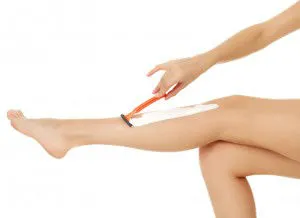
- Share on Facebook69
- Share on Pinterest
- Share on Twitter
Gals, if the mere thought of leaving your underarms, legs or other parts unshaven gives you the jitters, read on.
Shaving for women is a relatively new event in our history but was wildly popular with ancient cultures.
During the Roman Empire a lack of body hair was considered a sign of class. Upper class men and women would remove almost all of their body hair. Ancient Greeks, Romans and Egyptians would even use pumice stones to remove their hair, ouch!! According to a recipe dating back to 1532, women used a very dangerous mixture of arsenic and quicklime to remove hair on their legs, ouch again!!
Although we may not use as abrasive tools as ancient cultures – women still work very hard to keep their parts clean shaven. In fact, it is estimated that a woman may spend as much as 72 days of her life shaving.
So, why do we shave? Why do we worry so much when our legs aren’t silky smooth or we have a little stubble under our arms? To answer these questions and determine if letting it grow might not be the healthiest thing for us – we need to go back in history just a little bit.
Underarm shaving was not popular in America until around 1915 mostly because very few people ever saw the underside of a woman’s arm. In fact, even speaking the word “underarm” was considered vulgar language. It was not until 1915 that the first razor was marketed for women.
Once the sleeveless dress arrived on the scene, women and fashion advocates saw that there was a need to remove “objectionable” hair. By the 1920’s, hairy underarms were, for the most part, a thing of the past and products began hitting the shelf at high speed – razors, lotions, creams, etc.
Leg shaving took much the same turn as underarm shaving. As long as the legs were hidden, why did it matter? As the skirts shortened and more flesh was revealed, the need to shave became a must (at least that’s what the beauty industry told us). The shorter the skirt, the more hair that was removed.
Who doesn’t shave?
While the majority of American women shave their underarms and legs on a regular basis, there are also many who prefer to go au-naturel. Although there are women in most countries who choose not to shave, France and Italy seem to lead the way with the natural look. Choosing not to shave seems to be more of a personal preference than a cultural norm.
Is shaving a health risk?
Besides the nasty knicks that you get from time to time, it is unlikely that you have ever thought much about the health ramifications of shaving or even waxing. While shaving underarms and legs is for the most part, safe, shaving or waxing the private bikini area is another story.
Health experts tell us there is a reason why we have pubic hair. Not only does pubic hair protect against infection, it is also a natural shock absorber and makes sex less painful.
While researchers are not entirely sure why humans have hair in this area, some say it is to trap pheromones and others say it is to keep us warm. No matter the reason, think about it, no matter how much you shave or wax, it still comes back – so perhaps it was meant to be?
Statistics tell us that up to 60 percent of American women between the ages of 16 and 24 keep their private area completely shaven for any number of reasons, cleanliness being one of them. However, contrary to what these women think, shaving or waxing this area does not make a person cleaner.
In fact, removing pubic hair actually irritates and inflames hair follicles and leaves tiny open wounds behind. Frequent hair removal results in irritation of the shaved or waxed area and creates an environment where dangerous bacterial pathogens can thrive, such as streptococcus, staphylococcus and methicillin resistant staph aureus. The chance of developing staph boils and abscesses that may require painful drainage goes way up.
The real danger with shaving or waxing the private area is that it makes one more vulnerable to herpes and other sexually transmitted diseases along with cellulitis and abrasions.
What about hair removal lotions?
 Switching gears a bit, many women use hair removal lotions, sprays or creams to remove hair from their legs and underarms. The inherent danger with these products is the multitude of ingredients that you can’t pronounce. The most popular of these depilatory products is Nair. Nair contains chemicals that dissolve the protein structures of hair making it easy to wipe away.
Switching gears a bit, many women use hair removal lotions, sprays or creams to remove hair from their legs and underarms. The inherent danger with these products is the multitude of ingredients that you can’t pronounce. The most popular of these depilatory products is Nair. Nair contains chemicals that dissolve the protein structures of hair making it easy to wipe away.
So, that same ingredient, known as sodium hydroxide, that destroys the protein of your hair on your legs, is also found in caustic drain cleaners. This is what gives chemical hair removal products their strong smell and is also most likely the reason for the burning sensation. A quick search on the Internet even reveals how you can clean a clogged drain with Nair.
So, where does all this leave us? Shaving under your arms or your legs appears to be relatively harmless and is very much a personal choice. However, it appears as though caution must be taken when shaving ‘down there’, and if you must shave – avoid chemical shaving solutions like the plague.
-The Alternative Daily
- Share on Facebook69
- Share on Pinterest
- Share on Twitter

